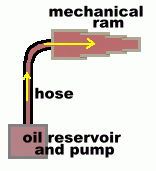 Hydraulics is the use of a liquid, usually oil, to do work by applying a force. Although air pressure can be used to do the same thing, air won't work for supplying large forces because air will compress, but a liquid won't.  Here is a close-up of the molecules in a gas. They are far apart, which means if you use them to supply a force, they will just compress ... move closer together. Pushing heavy loads with a gas would be like trying to push with a marshmallow ... it would just squish together.  Here is a close-up of a liquid's molecules. Here is a close-up of a liquid's molecules.The molecules are already as close together as they can get, under normal circumstances. Pushing with a liquid is just like pushing with a steel rod, as long as you keep the molecules confined (since a liquid has no fixed shape). The advantage of pushing with a liquid in a hydraulic system, instead of steel rods, is that a liquid can bend around corners; it can follow the shape of the hose that holds it. You can supply a push to the liquid in an original direction, and that push will bend itself around corners and go to where you need the force applied.
|
